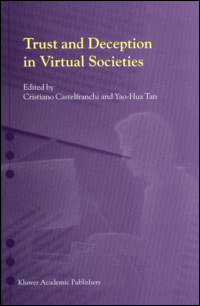Reviewed by
Helder Coelho
Department of Informatics,
University of Lisbon, Portugal.

The logic of a workshop consists of selecting a hot topic, inviting a number of people and hoping that everyone has the courage to face the topic and bring new ideas to clarify its nature and meaning. Therefore, organising a workshop involves great intelligence and energy in order to assemble the proposals, to sequence the confrontations and, finally, to put forward the results. Usually, when reading the proceedings of a workshop, one cannot find the juice of the discussions and the overall conclusions. It seems that these last two issues require effort and long work. At the end of the day, it seems that an organiser is seldom available and willing to carry it out.
The present volume of proceedings on "Trust and Deception" displays the above tendencies. It collects the main papers, opens with a general introduction and presents some order and structure for linear reading. However, I had great difficulty in discovering the contents of the discussions and the final results of the workshop: what was agreed and accepted. And, I think this is a pity because the follow up workshops cannot easily explore what was left open and to be discussed. Anyhow, the book starts with a clear picture of the theme of trust written by the two editors. However, at the end of the introduction, this theme stops abruptly, without any further explanation.
Trust, the operative word of the workshop, deals with maintaining order and calm during an extended period of "conversation". But to be believed, the messages coming from agents have to, at least, acknowledge the patterns being recognised (or perhaps generated) by all those interested in exchanging ideas. Even messages that seem to have a low probability of being true or relevant should be taken seriously, if only to keep the confidence of those participating in the conversation. Of course, part of this honest stance arises because nobody really knows what is coming next and is therefore in a position to expect something different. If this is not the case, deception may occur.
"Trust is relevant in human-computer interaction, for example in the trust relation between the user and her/his personal assistant. It is also critical for modelling and supporting groups and teams, organisations, co-ordination, negotiation, with the related trade off between local/individual utility and global/collective interest; or in modelling distributed knowledge and its circulation." (Falcone and Castelfranchi, 2001).
The book is divided in two main parts, one dedicated to theoretical issues (chapters 1, 2, 3, 4, 5, 8, 10) and another covering the applications (chapters 6, 7, 11, 12). However, the boundary of the division and the order of the papers is not trivial (electronic commerce is present in chapters 2, 11 and 12). In the middle of the book, a reader may find two papers by Castelfranchi (with colleagues). These constitute the best value in the book, along with a nice experimental study, fully documented, in chapter 9. As all the chapters were based upon previous papers presented at the workshop, the editors had to face the difficult task of filling gaps, and sometimes this was not done. It would have been nice to see texts between the papers, establishing bridges and opening up spaces for confrontation and later discussion.
There is no section summing up the book and it is not clear what kind of conclusions were reached during the meeting. The Preface and Introduction also fail to say anything about the ideas that stand in need of further work. For an interested reader, I strongly suggest starting with Chapter 3 followed immediately by Chapter 4. These two papers alone justify the selection of this book and its inclusion in any AI library. The ideas in these papers are clearly defined and motivated, and we can see science at his best, covering both description and explanation.
Return to Contents
of this issue
© Copyright Journal of Artificial Societies and Social Simulation, 2002